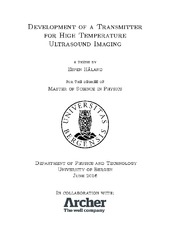| dc.description.abstract | This thesis presents the development and testing of a new transmitter in an ultrasound imaging tool used for imaging the inside of oil wells in temperatures of up to 180 degrees Celsius. The imaging tool can have up to 288 transducer elements, driven by 16 transmitters. This generates a need for lots of switches, increasing the load capacitance, which results in a demanding current requirement. Every part of the original transmitter is analyzed and potential improvements is proposed and implemented. After improving the design and component choices, a new layout is performed for one channel, using the same area as the old channel. Both the old and new design is soldered on one PCB to test them under the exact same circumstances. Tests have been done during the design process to verify components and to obtain coefficients for calculating core loss. This is used for calculating core loss and optimizing the core size. With ultrasound imaging, the resolution is highly dependent on signal frequency. This is why Bergen Technology Center uses ultrasound transducers with upper frequencies of up to 6 MHz, especially for thickness measurements. But, the transmitter in use today for driving the transducers is only capable of maximum output signals up to 2 MHz. The new design has been tested both with dummy loads and in a complete tool. Tested with a complete ultrasound imaging tool, the new transmitter showed an increase in amplification from the old design of 24 dB at 6 MHz. Temperature tests have been performed with dummy loads up to an ambient temperature of 180 degrees Celsius. With maximum frequency, temperature and frame rate, the new design shows an amplification of 36 dB, 23 dB higher than the old design under the same circumstances. Temperature rise of the critical components has been logged during the tests, and is used with power dissipation for calculating thermal resistance. Improvements has also been proposed for other parts of the imaging tool. New switches are proposed that will reduce the switch capacitance with 29 %, improving slew rate and output signal amplitude. A modification of the input signal is proposed that will decrease the output pulse duration and give better axial resolution. | en_US |
